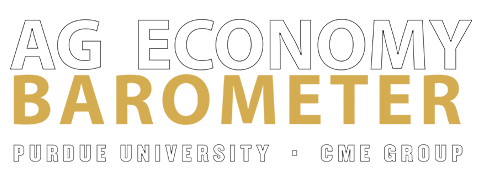Survey Methodology
On a monthly basis, 400 U.S. agricultural producers are surveyed to discern their attitudes and sentiments regarding the status of the U.S. farm economy. Specifically, responses to five questions are used to generate the Ag Economy Barometer value each month. The questions are:
- We are interested in how farmers are getting along financially. Would you say that your operation today is financially better off, worse off, or about the same compared to a year ago?
- Now, looking ahead, do you think that a year from now your operation will be better off financially, worse off, or just about the same as now?
- Turning to the general agricultural economy as a whole, do you think that during the next twelve months there will be good times financially, or bad times?
- Looking ahead, which would you say is more likely, U.S. agriculture during the next five years will have widespread good times or widespread bad times?
- Thinking about large farm investments – like buildings and machinery — generally speaking, do you think now is a good time or bad time to buy such items?
Ag Economy Barometer Calculation
The first step in computing the Ag Economy Barometer is to calculate the relative score for each of the five questions, which is the percentage of favorable responses minus the percentage of unfavorable responses, plus 100. This gives each question a potential range of scores from 200 (100 percentage points favorable less 0 percentage points unfavorable, plus 100) to zero (0 percentage points favorable less 100 percentage point unfavorable, plus 100).
The relative scores from each of the questions for that month are then added together and divided by the average value for the base period, which was October 2015 to March 2016. The result is then multiplied by 100, yielding the Ag Economy Barometer value for that month.
Interpreting the Agricultural Economy Barometer Values
The Ag Economy Barometer value for a given month is always relative to the base period (October 2015 to March 2016). A Barometer value of 100 implies no change from the base period. A value greater than 100 indicates an increase in producers’ sentiment compared to the base period, whereas a value below 100 indicates producers’ sentiment declined relative to the base period.
Survey Details
The producer survey collects survey responses from 400 producers whose annual market value of production is equal to or exceeds $500,000. Furthermore, to ensure that our survey results accurately represent this group of key agricultural producers, our survey respondents are stratified such that they correspond with USDA’s Census of Agriculture. To ensure consistency with USDA’s Census, we use phone sampling to establish response targets based on value of farm production as follows: 49 percent of respondents with a market value of agricultural production ranging from $500,000 to $999,999; 36 percent of respondents with production values ranging from $1,000,000 to $2,499,000; and 15 percent of respondents with a market value of production equal to or greater than $2,500,000. Stratifying our targeted responses in this manner helps ensure that survey results accurately assess opinions of the primary drivers of the U.S. farm economy. Furthermore, a stratified sample reduces sampling variability, which becomes critical to the reliability of survey results as we sample producers month after month. This approach helps ensure that changes in survey results over time are attributable to changing attitudes of farmers, rather than a change in the distribution of farmers surveyed.
In addition to response targets based upon value of farm production, we also stratify respondents to ensure that major agricultural enterprises are adequately represented. The key agricultural enterprises to be targeted include the following: corn/soybeans; wheat; cotton; beef cattle; dairy; hogs. These enterprises collectively account for 67 percent of all US agricultural production. Again, relying on USDA’s census data, we target a distribution of farms across these key enterprises among survey respondents. Since a single farm can engage in multiple enterprises, and the categories are not mutually exclusive, the proportions represent a minimum. Minimum targets by enterprise for survey respondents are as follows: 53 percent corn/soybeans, 14 percent wheat, 3 percent cotton, 19 percent beef cattle, 5 percent dairy, and 6 percent hogs. Finally, our target of 400 respondents helps ensure results are reliable with a 95 percent confidence interval of +/- 5 percent.


